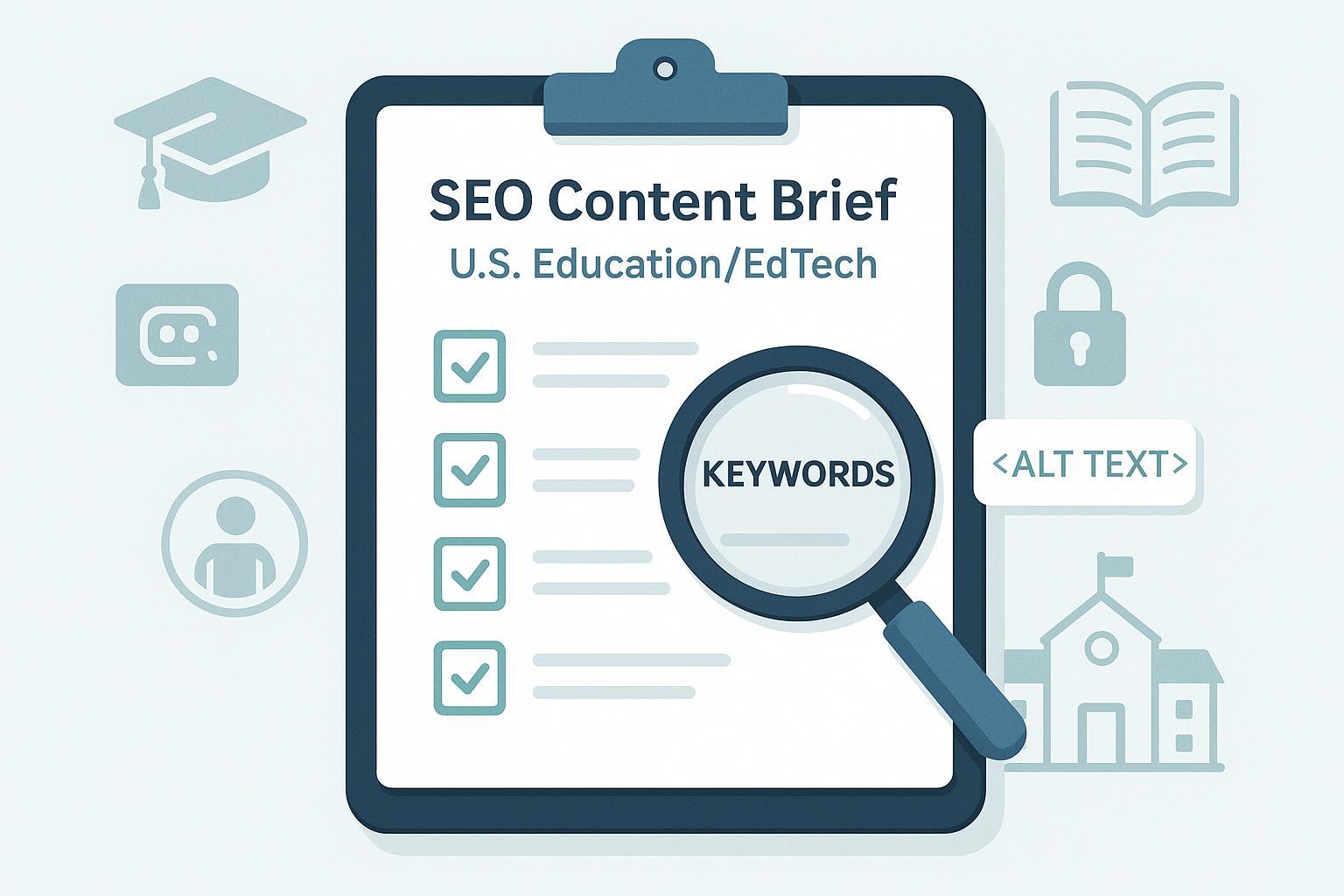SEO Content Brief Template for Education/EdTech (United States)

This practical checklist helps U.S. Education/EdTech teams produce compliant, people-first SEO content without guesswork. Use it for blog posts, program pages, resource hubs, landing pages, and comparison pages across K–12, Higher Ed, and B2B EdTech.
How to use this template
- Work through modules in order: Strategy → Audience & Intent → Keywords → Compliance → E-E-A-T → On-page plan → Accessibility → Schema/SERP → Drafting → Review & QA → Publish → Measure & Refresh.
- Mark each item as M (Mandatory), R (Recommended), or O (Optional) to align with your team’s maturity.
- Keep language student-, parent-, and educator-friendly; avoid legal advice. For edge cases, consult institutional counsel.
1) Strategy & Goals
- Define the primary goal and KPIs (M): State what success looks like (e.g., qualified RFI starts, demo requests, snippet capture, .edu backlinks).
- Identify the asset type and funnel stage (M): Blog/how-to vs program page; awareness vs consideration vs decision.
- Clarify the unique angle or experience evidence (M): Note practitioner insights or anonymized outcomes you’ll include.
2) Audience & Intent
- Specify the target persona(s) (M): K–12 parents/teachers, Higher Ed prospects, or district admins/CIOs.
- Classify user intent (M): Informational, evaluative/commercial, or transactional; add top questions the page must answer.
- Set reading level and tone (M): Parent-friendly and scannable for K–12; student-formal for Higher Ed; precise and technical for B2B IT/admin.
3) Keyword Plan
- Confirm primary keyword and variants (M): Include long-tail queries and synonyms.
- Map keywords to sections (R): Assign headings to intent clusters (definitions, steps, comparisons).
- Note seasonality and regional modifiers (R): Back-to-school, FAFSA cycles, district/state terms.
4) Compliance Overlay (FERPA, COPPA, ADA/WCAG)
- Check FERPA implications for any student information (M): If using identifiable education record details (e.g., GPA, program status), obtain prior written consent as specified in 34 CFR 99.30; include who, what, purpose, and recipient in the consent documentation. See the regulatory consent requirements in the ECFR 34 CFR 99.30 (U.S. Department of Education, current regulations) (cite the year in your brief).
- Use de-identified or aggregate data when possible (M): Remove personally identifiable information and ensure students cannot reasonably be re-identified; guidance for researchers is outlined on the ED.gov Student Privacy portal (StudentPrivacy.ed.gov, audience: researchers, accessed 2025).
- Respect directory information opt-outs (M): Before publishing names/photos classified as directory info, confirm public notice and opt-out status; see general guidance at the StudentPrivacy.ed.gov portal (U.S. Department of Education, 2025).
- Determine COPPA applicability (M): If your site/app is child-directed or has actual knowledge of under-13 users, prepare compliant notices and consent flows. The FTC’s 2025 update details limits on monetizing kids’ data and parental rights; review the FTC 2025 COPPA Final Rule press release (Federal Trade Commission) and the Federal Register COPPA Rule text (2025 update).
- Minimize data collection and retention (M): For COPPA, collect only what’s necessary; document retention/deletion schedules and third-party disclosures.
- Bake in accessibility per WCAG 2.2 AA (M): Provide text alternatives, captions/transcripts, adequate color contrast, descriptive link text, and logical headings. Implementation guidance is in the W3C WCAG 2.2 specification (World Wide Web Consortium, 2023–2024).
- Align with ADA/DOJ expectations for public entities (M): Schools/districts should maintain accessible web content and mobile apps, publish accessibility statements, and establish remediation processes. See the ADA.gov web content and mobile apps fact sheet (U.S. Department of Justice, 2024) and the ADA.gov small entity compliance guide (DOJ, 2024).
5) E-E-A-T & Trust Signals
- Assign an expert author with credentials (M): Educator, instructional designer, admissions counselor, or EdTech solutions engineer.
- Add a reviewer line where appropriate (R): Privacy/accessibility reviewer for sensitive topics.
- Cite authoritative sources with descriptive anchors (M): Prefer .gov, .edu, W3C, and Google documentation.
- Include transparent site info and updated dates (R): About page, contacts, and page updated date.
6) On-Page SEO Plan
- Draft a descriptive, intent-matching title and H1 (M): Concise, accurate; avoid year in H1 unless truly time-sensitive.
- Outline headings and section flow (M): Ensure a logical H1 → H2 → H3 hierarchy; avoid skipping levels.
- Plan internal links (R): Link to prerequisite concepts and deeper guides; avoid overlinking.
- Prepare meta title and meta description (M): Include primary keyword and value proposition.
7) Accessibility Implementation Details
- Provide alt text for informative images; empty alt for decorative (M): Describe function and context per WCAG 2.2.
- Add synchronized captions and transcripts to all media (M): Cover prerecorded and live captions; include transcripts for audio-only.
- Verify color contrast and avoid color-only signifiers (M): Meet 4.5:1 contrast for text.
- Ensure focus visibility and keyboard navigation order (M): Test with NVDA/JAWS/VoiceOver; check tab order.
- Use descriptive link text (M): Make link purpose clear in context.
8) Schema & SERP Feature Strategy
- Select structured data types that fit the asset (M): Article for blogs; FAQPage for visible Q&A; HowTo for step-by-step; Course/EducationalOrganization for program pages; Event for open houses/webinars. See the Google structured data introduction (Search Central), Course structured data (Google, 2024), FAQPage structured data (Google, 2024), HowTo structured data (Google, 2024), and Event structured data (Google, 2024).
- Format content for featured snippets and PAA (R): Give concise 40–60-word definition/answer blocks; use ordered lists for steps and tables for comparisons; reference Google’s featured snippets guidance (Search Central, 2024).
- Validate markup (M): Use Rich Results Test; monitor enhancements in Search Console.
9) Drafting Guidance
- Open with a clear promise that matches intent (M): State what the reader will get and for whom.
- Show experience evidence early (M): Practitioner examples, anonymized data, and context.
- Use inclusive language and plain English (M): Avoid jargon unless targeting technical B2B readers.
- Structure for scanning (M): Short paragraphs, bullets, and descriptive subheads.
10) Review & QA Gates (Pre-publish)
- Run accessibility checks (M): Automated (Lighthouse/axe/WAVE) plus manual AT testing; document fixes.
- Fact-check with primary sources (M): Verify policy references (FERPA, COPPA, ADA/WCAG, Google docs).
- Validate schema and links (M): Rich Results Test; check link integrity and alt coverage.
- Perform originality and plagiarism scan (M): Ensure unique value.
- Include author bio and reviewer line where applicable (R).
11) Publishing & Distribution
- Add ethical CTAs suited to education (M): RFI form starts, counselor chat, demo request; avoid manipulative patterns.
- Repurpose for email/newsletters and social (R): Tailor for parents, students, or admins.
- Conduct outreach for backlinks (R): Education associations, faculty pages, and relevant .edu/.org opportunities.
12) Measurement & Refresh Cadence
- Set KPIs and tracking (M): Organic sessions, qualified leads, snippet/PAA capture, scroll depth, device conversions, .edu/.org backlinks.
- Define refresh cadence by topic sensitivity (M): Financial aid/policy topics sooner; evergreen topics on a longer cycle.
- Monitor Search Console and analytics (M): Watch rich results, CWV, and engagement metrics by segment.
Segment adaptation notes
- K–12 (M): Emphasize COPPA compliance, accessibility-first formatting, parent-centered language, and seasonality (back-to-school, testing windows). Include consent disclaimers for any UGC.
- Higher Ed (M): Focus on admissions queries, scholarship/FAFSA alignment, faculty credentials, and program comparators. Use Course and EducationalOrganization schema where relevant.
- B2B EdTech (M): Address integration keywords (SIS/LMS), security/compliance statements, ROI proof, and long buying committees; include technical details for IT/admin personas.
Copyable SEO content brief template (paste into your doc)
Title/H1:
Meta Title:
Meta Description:
URL Slug:
Goal & KPIs (M):
- Primary goal:
- KPIs (e.g., RFI starts, demo requests, snippets, .edu backlinks):
Asset Type & Funnel Stage (M):
- Type (blog/program page/landing page/resource hub):
- Stage (awareness/consideration/decision):
Unique Angle & Experience Evidence (M):
- Practitioner insight/data (de-identified):
Audience & Intent (M):
- Persona(s):
- Intent classification:
- Top questions to answer:
- Reading level & tone:
Keyword Plan (M/R):
- Primary keyword:
- Variants/long-tail:
- Section-to-keyword mapping:
- Seasonality/region notes:
Compliance Overlay (M):
- FERPA: consent needed? directory info? de-identification plan:
- COPPA: child-directed? notices/consent method? data minimization/retention:
- ADA/WCAG 2.2 AA: alt text, captions, contrast, headings, link text:
- ADA/DOJ: accessibility statement/process for schools:
E-E-A-T & Trust Signals (M/R):
- Author credentials:
- Reviewer line (privacy/accessibility):
- Authoritative citations planned:
- Updated date & site transparency:
On-Page SEO Plan (M):
- Title/H1:
- Headings outline:
- Internal link targets:
- Meta title/description:
Accessibility Implementation (M):
- Alt text plan:
- Captions/transcripts:
- Contrast check:
- Focus order/keyboard navigation:
- Descriptive links:
Schema & SERP Strategy (M/R):
- Schema types:
- Featured snippet/PAA formatting:
- Validation plan:
Drafting Guidance (M):
- Opening promise:
- Experience evidence:
- Inclusive language & structure:
Review & QA Gates (M):
- Accessibility (auto + manual):
- Fact-checking:
- Schema/links validation:
- Originality scan:
- Author bio & reviewer line:
Publishing & Distribution (M/R):
- Ethical CTAs:
- Email/newsletter/social repurposing:
- Backlink outreach targets:
Measurement & Refresh (M):
- KPIs & tracking:
- Refresh cadence:
- Search Console & analytics monitors:
Why these checkpoints matter (brief rationale)
- Accessibility and ADA/WCAG: Ensures equitable access and compliance; improves user satisfaction and discoverability. Align with the W3C WCAG 2.2 specification and DOJ guidance linked above.
- Privacy (FERPA/COPPA): Protects student data and parental rights; reduces risk. See ECFR 34 CFR 99.30 and FTC/Federal Register COPPA resources indicated earlier.
- E-E-A-T & Google guidance: Builds trust and people-first content; aligns with the Google SEO Starter Guide (Search Central) and featured snippets/structured data documentation noted above.
- Schema & SERP: Enhances eligibility for rich results and answers common questions directly.
- QA & Refresh: Maintains accuracy, performance, and credibility over time.
Adopt this checklist as your standard brief, and you’ll ship education-ready content that’s compliant, credible, and optimized for the queries your students, parents, and administrators actually search.

